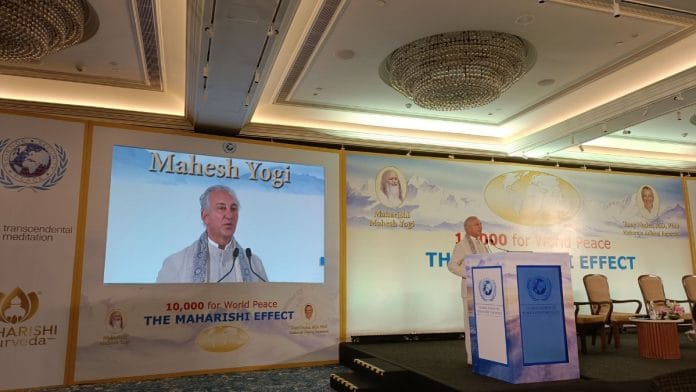New Delhi: From better grades in school to endless world peace, the transcendental meditation technique, created by spiritual leader Maharishi Mahesh Yogi, is touted as the one-stop solution for the world’s problems. Now, scientists are endorsing it too.
At a press conference held by the Global Union of Scientists for Peace (GUSP) in New Delhi’s Taj Mahal hotel, over 150 people gathered to promote their ‘scientifically proven’ technology to end global conflicts and promote peace in the world. The organisation’s two-week programme in Hyderabad, which started on 29 December, will be attended by 10,000 practitioners of transcendental meditation.
GUSP chairman Tony Nader is Mahesh Yogi’s successor for transcendental meditation (TM) organisations worldwide. At the Delhi event, Nader spoke about TM being a ‘fourth state of consciousness’ besides waking, sleeping, and dreaming. Academic studies, however, do not support this theory.
“Billions of dollars are spent on war in the world. We’re asking to spend a small portion of that on peace instead—by having a group of people permanently practise transcendental meditation,” Nader said at the event.
The speakers at the conference included scientists affiliated with the Maharishi International University in Fairfield, US. They explained the science behind transcendental meditation and claimed that it will end conflict in the world.
It is not an easy claim to defend. “I am sure there are studies that can reliably show effects in one’s personal life through meditation, like any behavioural practice,” Vidita Vaidya, a neuroscientist with the Tata Institute of Fundamental Research in Mumbai, said to ThePrint. “But to say it affects people miles away who don’t even know about the technique? That is a categorical statement you would require a lot of evidence to prove.”
Also Read: ‘No yoga at Taj Mahal’ — after viral Surya Namaskar video sparks row, ASI set to put up warnings
Field theory of consciousness
The science proposed by transcendental meditation says that ‘consciousness’ exists in a field, like the gravitational or magnetic fields. Magnetic or gravitational waves are well established phenomena studied in physics. On a similar note, TM practitioners theorise that the consciousness field is made up of brain waves. So, a group of people practising TM anywhere in the world would create positivity everywhere due to their brain waves travelling via the consciousness field.
The event featured a talk by John Hagelin, chairman of the Maharishi International University and the main propounder of the field theory of consciousness. Hagelin, a quantum physicist who ran for the United States presidential elections in 1996, has been previously criticised by peers for trying to extend the unified theories of physics to human consciousness.
However, this wasn’t the only scientific theory put forth by transcendental meditation practitioners. “All our processes have been subject to rigorous scientific inquiry, and it is reliable and systematic,” said Nader, more than once. He explained that the logic for choosing 10,000 people for the Hyderabad event was based on another scientific principle pushed by the organisation called the N-squared theory.
In exploring the intersection of science and spirituality, it is essential to consider how various scientific theories have been interpreted through different cultural lenses, often leading to unique conclusions about human consciousness and its impact on societal issues.
The number of people required to achieve peace in a particular area was decided based on this formula—the square root of 1 per cent of the total population of the region. The scientists didn’t explain how they reached this conclusion. But going by their logic, the square root of 1 per cent of the world’s 8.1 billion people was 9,000 people. “We added 1,000 more for safety,” Nader laughed.
He also emphasised the ‘simple’ procedure of transcendental meditation. “There’s no need for concentration; it is a simple mantra and technique that can be learned even by a 4-year-old,” Nader said to the room full of TM practitioners, members of GUSP, and representatives of the Maharishi Ayurveda company.
When asked about governmental acknowledgment of their practices, Nader said that governments were too slow to try new technologies. “It is up to private companies to take us forward. I invite all angel philanthropists to immediately create permanent world peace,” he said.
Also Read: Forget 10 days of vipassana. It’s been 20 years, but I am still a work-in-progress
Science as a crutch
Attendees at the conference, including Nader, also presented research papers published in journals such as The Journal of Mind and Behaviour and the Journal of Conflict Resolution on the correlation between transcendental meditation and stress levels, crime rates, drug-related deaths, and war in different regions of the world. All the papers were authored by professors of the Maharishi International University, or by academics affiliated with the university.
But correlation studies observe the relationship between two different variables like transcendental meditation and crime, without establishing a cause.
“Sometimes correlation studies are the only way to study a situation, but you need to be very careful and account for all other variables that could possibly influence the outcome,” cautions Vaidya.
Notably, a 1998 paper on the effects of TM on crime in Washington DC, which was presented at the Delhi event, left out factors that are known to influence crime such as population demographics, age, and income levels. The paper explained their absence by saying these factors vary slowly over years and “would not be relevant”.
Vaidya pointed out how scientific research needs to be proven across contexts and demographics for it to hold fast. “You need to begin with the assumption that you are wrong, and prove your hypothesis over and over again, but it would still be difficult to make concrete statements about creating world peace.”
She observed that there is often a tendency to use science as a crutch to validate many practices. “What is wrong with promoting transcendental meditation as a good practice in itself, without claims of it bringing world peace that are difficult to prove?”
(Edited by Theres Sudeep)






